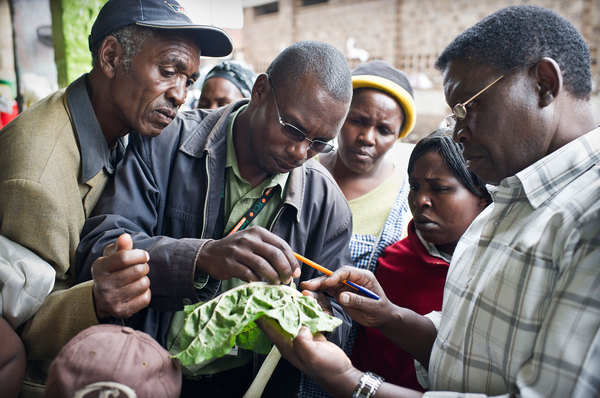The chicken or the egg?
“I started with just 100 chickens”, begins Mr Jean Claude Ruzibiza. He goes on to explain how from small beginnings he has now become Managing Director of Rwanda Best, a farm producing 4,500 eggs a day and growing fruit and veg to satisfy a significant part of nearby Kigali’s hungry population. With malnutrition in the world…
New report reveals cost of Fall Armyworm to farmers in Africa, provides recommendations for control
CABI has published an ‘evidence note’ report on the invasive Fall Armyworm pest, showing how the caterpillar could cause maize losses costing 12 African countries up to US$6.1 billion per annum, unless control methods are urgently put in place. Fall Armyworm: Impacts and Implications for Africa was commissioned by the UK’s Department for International Development (DFID)…
PRISE: speaking to the end user – pest alerts for plant doctors in Africa
After 2 hours drive, we arrive in Rufunsa District located approximately 150 kilometres east of the Zambian Capital, Lusaka. After exchanging pleasantries we settle down with Brian Siame, a trained plant doctor and one of the participants in our survey to find out more about plant doctor requirements for pest alert messages. After a brief…
Citrus Greening in Grenada
[youtube https://www.youtube.com/watch?v=KNlZQMRDNBU&w=560&h=315] Citrus Greening, also known as Huanglongbing, was first confirmed in Grenada in 2016. The disease is caused by bacteria which are spread by the Citrus psyllid. The disease causes yellow blotchy mottling on leaves, small lopsided fruit and branch dieback, making the tree uneconomical. Due to Citrus greening’s potential to devastate Citrus yields,…
Fall armyworm could cost Africa $2bn+ in lost harvest
Last week, CABI confirmed that since it arrived in Africa in 2016, the Fall Armyworm (FAW) has been reported in 28 African countries, presenting a now permanent agricultural challenge for the continent. FAW mainly affects maize and can cut yields by up to 60%. In research funded by the UK’s Department for International Development (DFID), CABI…
E-plant clinics pilot launched in Bangladesh
Plantwise programme was launched in Bangladesh with Plant Protection Wing (PPW), Department of Agricultural Extension (DAE) in 2015 after signing MOU with Ministry of Agriculture and Economic Relations Division of Ministry of Finance. The programme initially started with establishment of 10 plant clinics in 5 districts and is gradually scaled up to 30 plant clinics…
INIA y Plantwise desarrollan entrenamiento en uso seguro de plaguicidas
La agricultura en el Perú se ha expandido rápidamente desde el 2000. Según el Instituto Nacional de Estadística e Informatica del Perú, el Producto Bruto Interno agrícola se ha más que duplicado entre 2000-2016. Este crecimiento estuvo relacionado a la ocupación de nuevas áreas agrícolas, pero…
How ICTs are key to Plantwise's sustainability
The Plantwise programme has expanded in terms of its plant clinic network, the number of countries involved and the number of farmers reached since its launch in 2011. This expansion has been facilitated to a significant extent by an ICT infrastructure, i.e. the Knowledge Bank and e-plant clinics (plant clinics equipped with tablets). Mozambique, Nepal, Malawi, Nicaragua…
Managing Tuta absoluta in Agricultural production systems
Adapted from ‘Tomato leaf miner/ American leaf miner management in Agricultural production systems (Distribution, biology, damage and integrated management)’ written by Koppert Biological Systems. The tomato leaf miner, Tuta absoluta, is a devastating pest of tomato. Originating from Latin America, T. absoluta has spread via infested fruits and packaging material to Europe, North Africa and the…
Extender del Programa Plantwise a Nuevas Áreas del Perú
Con el apoyo de todas las agencias de donantes que apoyan el programa Plantwise y a traves de un trabajo conjunto con el INIA y gobiernos locales el programa INIA-CABI Plantwise viene siendo implementado en el Perú desde el 2012. A través de la utilización de los Módulos de Asistencia Técnica – Clínicas de Plantas como…


